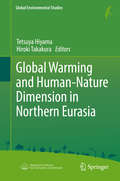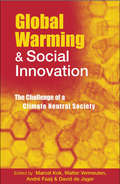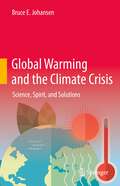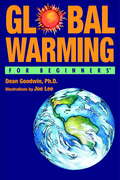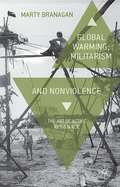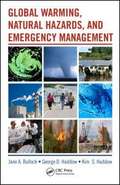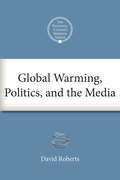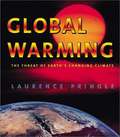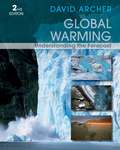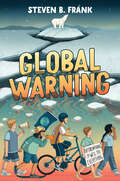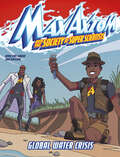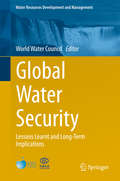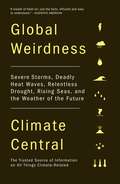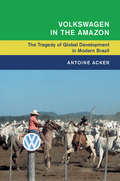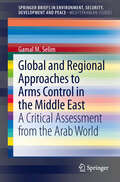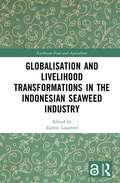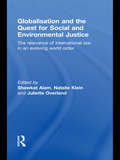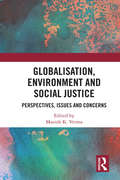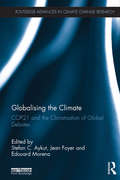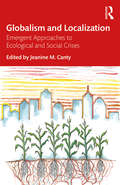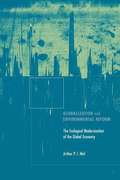- Table View
- List View
Global Warming and Human - Nature Dimension in Northern Eurasia
by Tetsuya Hiyama Hiroki TakakuraThis book describes the current environmental changes due to global warming in northern Eurasia, especially focusing on eastern Siberia. Spring flooding, ice-jam movements, and monitoring using remote sensing are included. Additionally, current reindeer herding of indigenous peoples in Siberia and related environmental changes such as waterlogging, rising temperatures, and vegetation changes are addressed. As a summary, the book also introduces readers to adaptation strategies at several governmental levels. The book primarily focuses on 1) introducing readers to global warming and human/nature dynamics in Siberia, with special emphasis on humidification of the region in the mid-2000s, and 2) describing social adaptation to the changing terrestrial ecosystem, with an emphasis on water environments. Adaptation strategies based on vulnerability assessments of environmental changes in northern Eurasia are crucial topics for intergovernmental organizations, such as the IPCC (Intergovernmental Panel on Climate Change). Thus, the book offers a valuable resource not only for environmental researchers but also for several stakeholders regarding global environmental change.
Global Warming and Social Innovation: The Challenge of a Climate Neutral Society
by Andre Faaij David Jager Marcel KokSocieties need to reduce emissions of greenhouse gases by 80 per cent in order to counter the risks of climate change. This study envisions a climate neutral society - one where the output of polluting gases is minimised by social innovations set up in households, by local authorities, through developments in information and communications technologies and dematerialization, and through the shift towards product service systems and emissions trading. The work discusses the possibilities for steering and orchestrating this long-term transition towards a climate-friendly society, mapping paths through current dilemmas in climate policy and exploring the legal issues of making this transition.
Global Warming and the Climate Crisis: Science, Spirit, and Solutions
by Bruce E. JohansenThis textbook introduces readers to basic scientific principles of climate change. Based on extensive empirical evidence, it explains weather events that indicate climate change’s evolution and presents important topics connected to climate change, such as political controversies, climate policy, as well as Native American perspectives. Finally, it presents attempted solutions, including policy recommendations and technological proposals for necessary changes in our world.Providing a well-written and easy-to-follow overview of knowledge of science-based geophysical facts, including thermodynamics, the book puts a strong emphasis on why expeditious action on global warming is urgent. The book also explains why smart greenhouse-gas reduction strategies will ignite economic growth, generate new domestic jobs, protect public health, and strengthen energy security.Not assuming a scientific background on the part of the reader, Global Warming and the Climate Crisis: Science, Spirit, and Solutions offers an ideal supplemental reading in many types of courses in Earth sciences, climate policy, climate change sciences, as well as politics of climate change, from high school through undergraduate. General readers also will benefit from its treatment of this very important and timely issue.
Global Warming for Beginners
by Dean GoodwinThe science is in: Global warming is for real. But what does it all really mean, and what can or should we do about it? This clear, fluid narrative by a leading scientist and educator takes a scrupulously balanced approach in explaining for the reader the history of global climate monitoring and change, and the who’s, how’s, what’s, when’s, where’s and why’s of the interaction between human activity and recent trends in the Earth’s climate. Global Warming For Beginners is organized into five compelling sections: Global Warming, An Introduction The Cause The Consequences The Solutions What Steps Can I Take? Working from the premise that no one can do everything but everyone can do something, Goodwin challenges readers with experiments they can conduct to gain a better understanding of the science underlying the problems facing our planet, and concludes with a list of fifty easy actions people can choose from to start doing their part in the effort to slow or stop global warming. As with all For Beginners titles, this volume is illustrated throughout with entertaining drawings that help readers understand and retain the information in Goodwin’s lively and comprehensive text.
Global Warming, Militarism and Nonviolence
by Marty BranaganMilitarism is the elephant in the room of global warming. Of all government sectors, 'Defence' has the highest carbon footprint and expenditure, yet has largely been exempt from international scrutiny and regulation. Marty Branagan uses Australian and international case studies to show that nonviolence is a viable alternative to militarism for national defence and regime change. 'Active resistance', initiated in Australian environmental blockades and now adopted globally, makes the song 'We Shall Not Be Moved' much more realistic, as activists erect tripod villages, bury, chain and cement themselves into the ground, and 'lock-on' to machinery and gates. Active resistance, 'artistic activism', and use of new information and communication technologies in movements such as the Arab Spring and 'Occupy' demonstrate that nonviolence is an effective, evolving praxis.
Global Warming, Natural Hazards, And Emergency Management
by George Haddow Jane A. Bullock Kim HaddowScientists predict the earth is facing 40-to-60 years of climate change, even if emissions of carbon dioxide and other global warming gases stopped today. One inevitable consequence of the greenhouse gases already in the atmosphere will be an increase in the frequency and severity of natural disaster events. Global Warming, Natural Hazards, and Emergency Management documents the imperative need for communities to prepare for the coming effects of climate change and provides a series of in-depth, road-tested recommendations on how to reduce risks for communities and businesses. Frontline Advice for Increasing Defenses and Reducing Impacts of Global Warming Authored and edited by emergency management and environmental protection professionals from the Federal Emergency Management Agency (FEMA) and the Sierra Club, this book offers case histories from communities across America that have successfully reduced the extent and consequences of natural disasters. These examples are becoming increasingly important to understand and replicate as the risks to communities created by a changing climate rise. This book recognizes three fundamental principles essential to developing a disaster-prevention strategy: The protection of natural systems is an important security measure The reduction of disaster risk, not just response, is of great importance Local communities must take the lead in prevention efforts Provides Local Governments with Replicable Case Histories of Hazard Mitigation Efforts This no-nonsense reference is a procedural roadmap for emergency managers, policy makers, and community officials. It explains how to develop community partnerships among a myriad of stakeholders; identifies staffing and resource requirements for successful programs; and provides a step-by-step demonstration of the disaster-planning process at the community level.
Global Warming, Politics, and the Media
by David Roberts Eban GoodsteinOn September 21, 2011, David Roberts participated in The National Climate Seminar, a series of webinars sponsored by Bard College's Center for Environmental Policy. The online seminars provide a forum for leading scientists, writers, and other experts to talk about critical issues regarding climate change. The series also opens a public conversation, inviting participants to ask questions and contribute their own thoughts. Roberts is a Senior Staff Writer at Grist, one of the web's most popular sites for environmental news and commentary, so he is distinctively qualified to discuss the relationship between global warming, politics, and the media. In his lecture, Roberts argued that environmentalists' traditional criticism of climate change coverage--namely that journalists describe global warming as a debatable theory rather than as fact--is no longer the issue. Most media accept the reality of climate change--but it is treated as a specialty issue, rather than as a phenomenon that affects myriad aspects of life. The seminar focused on how to change that perception--how to make climate a backdrop to the political debates that affect real change. This E-ssentialis an edited version of Roberts' talk and the subsequent question and answer session. While some material has been cut and some language modified for clarity, the intention was to retain the substance of the original discussion.
Global Warming: A Beginner's Guide to Our Changing Climate
by John Gribbin Fred PearceBig ideas made simple -- six books in an incredible new series that explains important scientific ideas more clearly than ever before. Climate change resulting from an increase in greenhouse gases is perhaps the greatest threat to our planet's future. Here, Fred Pearce examines the causes and dramatic effects, and what can be done to remedy the situation -- before it's too late. This stimulating new series uses an innovative mix of graphics, artwork, and photographs to explain and illuminate the most important scientific topics of the day. Unique in popular science guides, Essential Science uses bright, full-color images to make traditionally "difficult" subjects more accessible. Each title focuses on a scientific or technological topic that is currently provoking debate and is likely to have a widespread impact on our lives. Lively, readable text from top science writers ensures all readers -- from 14+ schoolchildren to academics -- gain a full understanding of the facts and related issues. Under the direction of renowned science writer John Gribbin, expert authors describe, in lively, jargon-free text, the principles and discoveries behind each subject, summarize what is currently known, and predict future issues and trends.
Global Warming: The Threat of Earth's Changing Climate
by Laurence PringleIt's not your imagination: Earth is getting warmer. Global warming is perhaps the most prominent environmental issue of the past decade. Award-winning writer Laurence Pringle describes the causes of this worldwide trend, exploring its past, present, and potential future damage to our climate, ecology, and economy. He also offers practical solutions that will help avert a global disaster of our own making.
Global Warming: Understanding the Forecast
by David Archer<P>Archer's Global Warming: Understanding the Forecast 2nd Edition, is the first real text to present the science and policy surrounding climate change at the right level. Accompanying videos, simulations and instructional support makes it easier to build a syllabus to improve and create new material on climate change. Archer's polished writing style makes the text entertaining while the improved pedagogy helps better understand key concepts, ideas and terms. <P>This edition has been revised and reformulated with a new chapter template of short chapter introductions, study questions at the end, and critical thinking puzzlers throughout. Also a new asset for the BCS was created that will give ideas for assignments and topics for essays and other projects. Furthermore, a number of interactive models have been built to help understand the science and systems behind the processes.
Global Warning
by Steven B. FrankA group of 12-year-old friends concerned about climate change proposes a new way to save the earth: amending the U.S. Constitution. Their project propels these activists on an amazing journey across America—and all the way to Norway—with plenty of outside-the-box hijinks and civil disobedience, as they work to save the planet and their futures on it. For sixth grader Sam Warren and his friends Catalina, Alistair, Jaesang, and Zoe, the effects of climate change are too pressing to ignore. Adults don’t seem to be up to the challenge of taking action to make real change, but kids know it’s their futures on the line. If their parents, teachers, and government officials won’t step up well, then, they will! And these young people will stop at nothing to save the planet and their futures on it. With a little help from a retired kids' rights lawyer and a grandma who knows how to march, they are ready to think big: Constitutional amendment big. But can a bunch of 12-year-olds really draft an amendment that protects the planet, get it to pass in Congress, and change enough hearts and minds across the country to get it ratified before the clock runs out? Steven B. Frank crafts another funny and fast-paced story of heightened-reality wish-fulfillment, loaded with the witty patter of smart kids, in this book that reads like Aaron Sorkin for middle grade and plumbs the complexities of the Constitution and the critical turning point of global climate change.
Global Water Crisis: A Max Axiom Super Scientist Adventure (Max Axiom and the Society of Super Scientists)
by Myra Faye TurnerMore than 70 percent of Earth is covered in water. Yet only about 3 percent of it is freshwater that people can use. Every year, parts of the world suffer through severe droughts, and millions of people don’t have easy access to clean drinking water. Why is there a shortage of clean and healthy water? In this nonfiction graphic novel, Max Axion and the Society of Super Scientists travel around the world to learn the reasons behind the global water crisis. Young readers can tag along to discover what causes water scarcity and find out ways they can help preserve this precious resource.
Global Water Security
by World Water CouncilThis book highlights the relationship between the water sector and various other sectors in order to establish an improved understanding of the importance of water resources as an essential cross-cutting vector of socio-economic development. The book is both policy and practice oriented and is not constrained by existing definitions on water security. It includes actual experiences of policy, management, development and governance decisions taken within the water sector, and examples on how these have affected the energy and agricultural sectors as well as impacted the environment, and vice versa, as appropriate. It also discusses trade-offs, short and long-term implications, lessons learnt, and the way forward. The book includes case studies on cities, countries and regions such as Australia, China, Singapore, Central Asia, Morocco, Southern Africa, France, Latin America, Brazil and California.
Global Weirdness: Severe Storms, Deadly Heat Waves, Relentless Drought, Rising Seas and the Weather of the Future
by Climate CentralProduced by Climate Central—a highly regarded independent, nonprofit journalism and research foundation founded in 2008—and reviewed by scientists at major educational and research institutions the world over, Global Weirdness summarizes, in clear and accessible prose, everything we know about the science of climate change; explains what is likely to happen to the climate in the future; and lays out in practical terms what we can and cannot do to avoid further shifts.<P> Sixty easy-to-read entries tackle such questions as: Is climate ever “normal”? Why and how do fossil-fuel burning and other human practices produce greenhouse gases? What natural forces have caused climate change in the past? What risks does climate change pose for human health? What accounts for the diminishment of mountain glaciers and small ice caps around the world since 1850? What are the economic costs and benefits of reducing carbon emissions?<P> Global Weirdness enlarges our understanding of how climate change affects our daily lives, and arms us with the incontrovertible facts we need to make informed decisions about the future of the planet and of humankind.
Global and International History: Of Limits and Growth
by Stephen J. MacekuraOf Limits and Growth connects three of the most important aspects of the twentieth century: decolonization, the rise of environmentalism, and the United States' support for economic development and modernization in the Third World. It links these trends by revealing how environmental NGOs challenged and reformed the development approaches of the US government, World Bank, and United Nations from the 1960s through the 1990s. The book shows how NGOs promoted the use of 'appropriate' technologies, environmental reviews in the lending process, development plans based on ecological principles, and international cooperation on global issues such as climate change. It also reveals that the 'sustainable development' concept emerged from transnational negotiations in which environmentalists accommodated the developmental aspirations of Third World intellectuals and leaders. In sum, Of Limits and Growth offers a new history of sustainability by elucidating the global origins of environmental activism, the ways in which environmental activists challenged development approaches worldwide, and how environmental non-state actors reshaped the United States' and World Bank's development policies.
Global and International History: The Tragedy of Global Development in Modern Brazil (Global and International History)
by Antoine AckerFrom 1973 to 1987, Volkswagen's (VW) 140,000 hectare 'pioneer' cattle ranch on the Amazon frontierlaid barethe limits of capitalist development. These limits were not only economic, with the core management of a multinational company engaged in the 'integration' of an extreme world periphery, but they were also legal and ethical, with the involvement of indentured labor and massive forest burning. Its physical limits were exposed by an unpredictable ecosystem refusing to submit to VW's technological arsenal. Antoine Acker reveals how the VW ranch, a major project supported by the Brazilian military dictatorship, was planned, negotiated, and eventually undone by the intervention of internationally connected actors and events.
Global and Regional Approaches to Arms Control in the Middle East: A Critical Assessment from the Arab World
by Gamal M. SelimSince the end of the Cold War, the Middle East has been the focus of various projects for the establishment of arms control (including CBMs) regimes. Whereas some of these projects were initiated at the global level, others were discussed and debated at the regional level. This book analyses the global and regional dynamics of arms control in the Middle East in the post-Cold War era. It examines American and European arms control projects, the contexts in which they were presented, the reactions of major regional actors, and their impacts on arms control efforts in the region. It assesses Arab perceptions of the motivations for and constraints on establishing arms control regimes. It also explores the prospects of regional arms control in the context of the ongoing Arab Spring with its ramifications for Arab regional politics, and provides a new perspective on arms control in the Middle East. This volume enriches the ongoing discourse, which to date has been dominated by mainly Western perspectives.
Global: a graphic novel adventure about hope in the face of climate change
by Eoin Colfer Andrew DonkinThis is a powerful, hopeful and timely story about the real effects of climate change: two young people on different continents whose lives are catastrophically changed by global warming. A graphic novel with glorious colour artwork throughout for children of all ages - from Eoin Colfer, previously Irish Children's Laureate, and the team behind Illegal, and his bestselling Artemis Fowl graphic novels.Yuki lives in an increasingly deserted Inuit township in Nova Scotia. One day she sets out into the wilderness of the Arctic tundra planning to photograph a rare grolar bear (a terrifying grizzly-polar crossbreed created by climate change) - if she can prove it's a grolar, she can protect it from being shot. With only her faithful dog for company and adrift on a fragment of melting glacier, she finds herself being stalked across the changing wilderness by a starving grolar bear, with only her wits and her harpoon to keep her alive.Sami lives in a fishing village on the Bay of Bengal. But because of the ever-rising ocean level, each day is a struggle to survive. One night, Sami sets out to return to his old, submerged family home, alone. He takes a deep breath and dives beneath the moonlit waters, hoping to find his past.But a cyclone is coming ... Illustrated by the talented Giovanni Rigano, this moving and important graphic novel will have breathtaking full-colour illustrations throughout.
Globalisation and Agricultural Landscapes: Change Patterns and Policy Trends in Developed Countries
by Jørgen Primdahl Simon SwaffieldWhilst agricultural landscapes are products of the local ecosystem and community in which they are situated, they are becoming increasingly affected by the same global issues, and are converging under the dynamics of globalisation. Combining landscape ecological research and an examination of relevant public policy, this book investigates the dynamic relationship between agricultural landscapes and the global change processes, such as urbanisation, by which they are being transformed. Landscape change is analysed in the context of biophysical patterns, market dynamics, and specific public policy frameworks, through a series of case studies from different OECD countries spanning Europe, Asia Pacific and North America. Particular emphasis is placed upon the way that landscapes are changing under differing policies of agricultural subsidy including the EU Common Agricultural Policy. This is an ideal resource for graduate students and researchers in landscape ecology and agriculture as well as policy analysts working in the agricultural sector.
Globalisation and Livelihood Transformations in the Indonesian Seaweed Industry (Earthscan Food and Agriculture)
by Zannie LangfordThis book explores the rapidly changing seaweed industry in Indonesia, the largest global producer of carrageenan-bearing seaweeds. Seaweed production in Indonesia has grown exponentially over the last twenty years, and rural communities across the country have embraced this new livelihood activity. This book begins with an examination of the global carrageenan seaweed industry, from the global market for carrageenan in processed foods, to the national and regional contexts in Indonesia across which it is farmed, processed, and traded. It then explores the ways that rural communities have reshaped their lives around seaweed production, with chapters on agrarian transformations, negotiations over access to sea space, farmer decision-making in presence of environmental, social and economic constraints, the role of women and casual labourers in the industry, and the marketing of seaweed through social networks. Based on a multi-disciplinary research initiative, this book demonstrates the interrelatedness of environmental, social and economic dynamics on seaweed production, processing and trade, and argues for key policy interventions to support the sustainable development of the industry in the context of climate change. It also provides a lens for understanding and improving the broader processes of sustainable rural development in a rapidly globalising and commercialising world. This book will be of great interest to students and scholars of aquaculture, food systems, agricultural economics, rural studies and sustainable development.
Globalisation and the Quest for Social and Environmental Justice: The Relevance of International Law in an Evolving World Order
by Shawkat AlamThere are few topics as controversial as globalisation. It is meant to bring economic growth and solve a range of social, cultural and humanitarian problems. However, there are significant debates in relation to the extent that the reality of globalisation reflects this idealized vision. In particular, globalisation has produced a highly interdependent world, rendering state boundaries meaningless and challenging the ideology and limits of certain areas of international law. This book will provide the opportunity to address some of the multifaceted issues provoked by the issue of globalisation. The book is an exploration of the intricate nexus that emerges as a result of globalisation, inextricably linking together issues of international law, human rights, environmental law and international trade law. Bringing together a number of experts in the field, the book focuses on the areas of social justice and environmental justice, and explores the links that exists between the two and the effect of globalisation on these areas. A variety of topics are addressed throughout the chapters of this book – including biodiversity, the law of the sea, biotechnology, child labour, the rights of women, corporate social responsibility, terrorism and counter-terrorism, water resources, intellectual property rights and the role of non-government organisations. As globalisation has many facets and actors, the contributions to the book engage with interdisciplinary research to deal with the various challenges identified, and critically explore both the potential of globalisation as a vehicle of sustainable and equitable development.
Globalisation, Environment and Social Justice: Perspectives, Issues and Concerns
by Manish K. VermaThis volume provides a comprehensive account of the connections between globalisation, environment and social justice. It examines varied dimensions of environmental sustainability; the adverse impact of globalisation on environment and its consequences for poverty, unemployment and displacement; the impacts on marginalised sections such as scheduled castes and tribes and women; and policy frameworks for ensuring environmental sustainability and social justice. The chapters build on detailed case studies from different parts of the world and deal with critical environmental issues such as global emissions, climate change, sustainable development, green politics, species protection, water governance, waste management, food production and governance besides education, inclusivity and human rights. Presenting a range of topics alongside new perspectives and discourses, this interdisciplinary book will be useful to students and researchers of political studies, sociology and environmental studies as well as policymakers and those working in the government and civil society organisations.
Globalising the Climate: COP21 and the climatisation of global debates (Routledge Advances in Climate Change Research)
by Edouard Morena Jean Foyer Stefan AykutFrequently presented as a historic last chance to set the world on a course to prevent catastrophic climate change, the 21st Conference of the Parties to the Climate convention (COP21) was a global summit of exceptional proportions. Bringing together negotiators, scientists, journalists and representatives of global civil society, it also constituted a privileged vantage point for the study of global environmental governance "in the making". This volume offers readers an original account of the current state of play in the field of global climate governance. Building upon a collaborative research project on COP21 carried out by a multidisciplinary team of twenty academics with recognised experience in the field of environmental governance, the book takes COP21 as an entry point to analyse ongoing transformations of global climate politics, and to scrutinise the impact of climate change on global debates more generally. The book has three key objectives: To analyse global climate governance through a combination of long-term analysis and on-sight observation; To identify and analyse the key spaces of participation in the global climate debate; To examine the "climatisation" of a series of crosscutting themes, including development, energy, security and migration. This book will be of great interest to students, scholars and policymakers of climate politics and governance, international relations and environmental studies.
Globalism and Localization: Emergent Solutions to Ecological and Social Crises
by Jeanine M. CantyConsidering the context of the present ecological and social crisis, this book takes an interdisciplinary approach to explore the relationship between globalism and localization. Globalism may be viewed as a positive emergent property of globalization. The latter depicts a worldwide economic and political system, and arguably a worldview, that has directly increased planetary levels of injustice, poverty, militarism, violence, and ecological destruction. In contrast, globalism represents interconnected systems of exchange and resourcefulness through increased communications across innumerable global diversities. In an economic, cultural, and political framework, localization centers on small-scale communities placed within the immediate bioregion, providing intimacy between the means of production and consumption, as well as long-term security and resilience. There is an increasing movement towards localization in order to counteract the destruction wreaked by globalization, yet our world is deeply and integrally immersed within a globalized reality. Within this collection, contributors expound upon the connection between local and global phenomenon within their respective fields including social ecology, climate justice, ecopsychology, big history, peace ecology, social justice, community resilience, indigenous rights, permaculture, food justice, liberatory politics, and both transformative and transpersonal studies.
Globalization and Environmental Reform: The Ecological Modernization of the Global Economy
by Arthur P. J. MolMany writers either glorify globalization or vilify it, particularly for its destructive environmental effects. In this book environmental sociologist Arthur Mol provides a more balanced understanding of the relationship between globalization and environmental quality. Mol bases his arguments on his theory of ecological modernization, which holds that although processes of modernization and globalization often result in environmental degradation, they also can encourage policies and programs designed to arrest degradation and improve environmental quality. Building on earlier ecological modernization studies that focused on Europe, North America, and East and Southeast Asia, Mol takes here a more global perspective. He also addresses the increasing roles of nonstate actors, especially international institutions, nongovernmental organizations, popular movements, and transnational corporations. After examining the confusion created by the failure to distinguish among globalization, global capitalism, and neoliberalism, Mol analyzes both globalization's destructive environmental consequences and its contribution to global environmental reform. Elaborating on the subject of reform, he focuses on three case studies, one involving the economic triad of the European Union, the NAFTA region, and Japan; one involving the relationship between the triad and developing countries; and one involving three developing countries: Vietnam, the Netherlands Antilles, and Kenya.
